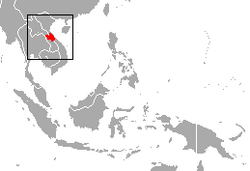Biology:Hatinh langur
| Hatinh langur[1] | |
|---|---|
| Scientific classification | |
| Domain: | Eukaryota |
| Kingdom: | Animalia |
| Phylum: | Chordata |
| Class: | Mammalia |
| Order: | Primates |
| Suborder: | Haplorhini |
| Infraorder: | Simiiformes |
| Family: | Cercopithecidae |
| Genus: | Trachypithecus |
| Species group: | Trachypithecus francoisi group |
| Species: | T. hatinhensis
|
| Binomial name | |
| Trachypithecus hatinhensis (Dao, 1970)
| |

| |
| Hatinh Langur range | |
The Hatinh langur (Trachypithecus hatinhensis)[3] is a highly threatened Old World monkey found in limestone forests in Vietnam, primarily in the Quảng Bình Province. A recent survey discovered a small population living in the Quảng Trị Province. Contrary to its name, it is not known from the Hà Tĩnh Province. The local Van Kieu minority refer to this monkey as the 'Con Cung', which roughly translates as "black, cliff-dwelling monkey with a long tail".[4] It resembles the closely related François' langur (T. francoisi), but its white cheek-stripes typically extend behind the ears onto the nape (there are significant individual variations, however), and the overall black colour is non-glossy and has a brownish tinge.[5]
This diurnal, largely arboreal langur is social and typically seen in groups of 2-15, but occasionally groups may number as many as 30 individuals.[6] It has often been considered a subspecies of the François' langur, but was elevated to a full species by Bradon-Jones in 1995,[7] and this was followed by Groves, 2005.[1] Both, however, listed it as a subspecies in 2004,[8] and genetic work suggest it should be considered a subspecies of the Laotian langur (T. laotum).[9][10] Morphological and genetic data also suggests the Indochinese black langur (T. ebenus) is a morph of the Hatinh langur.[5][9][10]
References
- ↑ 1.0 1.1 Groves, C.P. (2005). Wilson, D.E.; Reeder, D.M.. eds. Mammal Species of the World: A Taxonomic and Geographic Reference (3rd ed.). Baltimore: Johns Hopkins University Press. p. 177. ISBN 0-801-88221-4. OCLC 62265494. http://www.departments.bucknell.edu/biology/resources/msw3/browse.asp?id=12100722.
- ↑ Quyet, L.K.; Coudrat, C.N.Z.; Phiaphalath, P.; Nadler, T.; Covert, H. (2021). "Trachypithecus hatinhensis". IUCN Red List of Threatened Species 2021: e.T40789A196139355. doi:10.2305/IUCN.UK.2021-1.RLTS.T40789A196139355.en. https://www.iucnredlist.org/species/40789/196139355. Retrieved 19 November 2021.
- ↑ "ITIS Standard Report Page: Trachypithecus hatinhensis". https://www.itis.gov/servlet/SingleRpt/SingleRpt?search_topic=TSN&search_value=944280.
- ↑ Vietnam survey team finds rare primate. BirdLife International news. Accessed 2008-07-15
- ↑ 5.0 5.1 Nadler, T. (2010). Color variation in Hatinh langurs (Trachypithecus [laotum] hatinhensis). Vietnamese Journal of Primatology 4: 13-18.
- ↑ Nguyen Manh Ha. 2006. Some Observations on the Hatinh langur, Trachypithecus laotum hatinhensis (Dao, 1970), in North Central Vietnam. Primate Concervation. 21: 149-154. Available online (PDF)
- ↑ Bradon-Jones, D. 1995. A revision of the Asian pied leaf monkeys (Mammalia: Cercopithecidae: Superspecies Semnopithecus auratus), with the description of a new subspecies. Raffles Bull. Zool. 43: 3-43
- ↑ Bradon-Jones, D., A. A. Eudey, T. Geissmann, C. P. Groves, D. J. Melnick, J. C. Morales, M. Shekelle, and C. B. Stewart. 2004. Asian primate classification. International Journal of Primatology. 23: 97-164.
- ↑ 9.0 9.1 Roos, C. 2004. Molecular evolution and systematics of Vietnamese primates. In: Nadler, T., U. Streicher, and Ha Thang Long (eds). Conservation of Primates in Vietnam: 23-28.
- ↑ 10.0 10.1 Roos, C., T. Nadler, Y. P. Zhang, H. Zischler. 2001. Molecular evolution and distribution of the superspecies Trachypithecus [francoisi]. Folia Primatol. 72: 181-182.
Wikidata ☰ Q1206187 entry
 |


